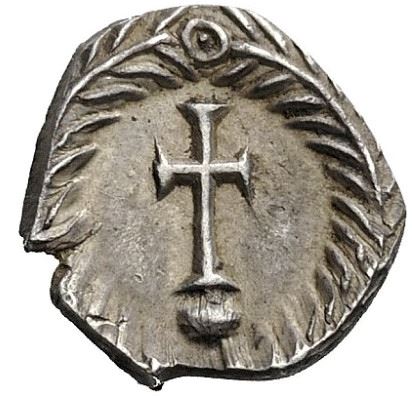Siliqua is the modern name given (without any ancient evidence) to small, thin, Roman silver coins produced in the 4th century A.D. and later.
Correspondingly, the half-siliqua is a coin weighing half of what the siliqua weighed.
When the coins were in circulation, the Latin word siliqua was a unit of weight defined as one twenty-fourth of the weight of a Roman solidus.
Correspondingly, the half-siliqua is a coin weighing half of what the siliqua weighed.
When the coins were in circulation, the Latin word siliqua was a unit of weight defined as one twenty-fourth of the weight of a Roman solidus.

(1)
Ostrogoths

An
AR
Half-Siliqua
struck 493-526
in
Italia
Obverse: Tiny head left facing Justin I with DIIVΛDƆSVIISIIΛ
Reverse: Chain wreath outer with VICTOII / SRM/ CON
Diameter:
15.4 mm
Die Orientation: 0 H
Weight: 1 g
Die Orientation: 0 H
Weight: 1 g
Commonly referred to as Gepids siliqua
Gennari type 4
(2)
Ostrogoths

An
AR
Half-Siliqua
struck 493-526
in
Italia
Obverse: right facing Anastasius with the text DИANAƧTΛ (…) VƧPΛ
Reverse: Theoderic monogram ИVICΓΛ+NROMΛ
Diameter:
13 mm
Die Orientation: 0 H
Weight: 0.8 g
Die Orientation: 0 H
Weight: 0.8 g
Commonly referred to as “Gepids siliqua”
No references provided for this coin
(3)
Ostrogoths

An
AR
Half-Siliqua
struck 493-526
in
Italia
Obverse: Right facing bust text reads STISSΛNV
Reverse: Theoderic monogram used by Witigis and Baduila Text VΛΛVIT+IIYGNV
Diameter:
14.1 mm
Die Orientation: 0 H
Weight: 1 g
Die Orientation: 0 H
Weight: 1 g
Commonly referred to as “Gepids siliqua”
No references provided for this coin
(4)
Vandals

An
AR
Half-Siliqua
struck 576-565
in
Carthage
Obverse: Left facing bust of Justinian II(?) IIVADPSVISTSΛIIΛ
Reverse: Monogram of Justinian II
Diameter:
12.5 mm
Die Orientation: 0 H
Weight: 1 g
Die Orientation: 0 H
Weight: 1 g
Commonly referred to as “Gepids siliqua”
No references provided for this coin
